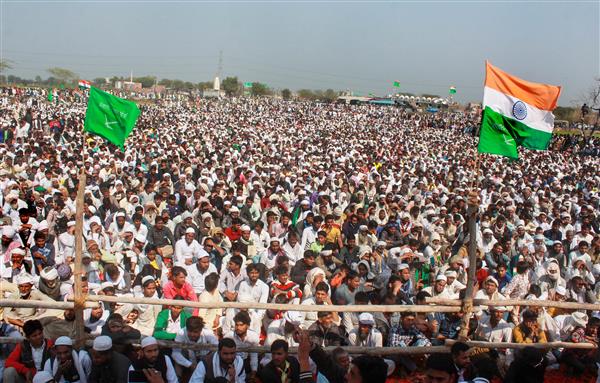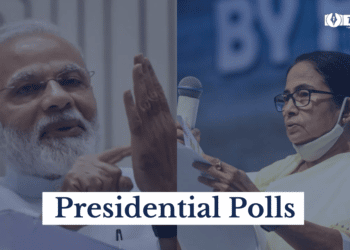I want you to remember the day of November 25, 2020, when the farmers of Punjab and Haryana, who were protesting at the local level against 3 agricultural laws, raised the slogan of ‘Delhi Chalo’ and decided to bring their struggle to the national level.
On June 5, 2020, the Modi government announced the introduction of the bill addressing three agricultural laws. Farmers’ protests erupted on this day as well, although due to the Corona lockdown, this demonstration was not completely visible on the road. Following that, on September 14, 2020, the administration introduced the agriculture law in Parliament via an ordinance, and on September 28, after the President’s assent, these ordinances became law.

Farmers’ organizations began protests on a local level. On the occasion of Constitution Day on November 26th, they called for a nationwide movement. Now, recall the day of November 25, 2020, when farmers en route to Delhi were hurled with sticks and water cannons in Ambala.
I want you to remember that on November 26th, farmers were halted on Delhi’s outskirts by barricading and employing force. Remember Amit Shah’s assertion that the administration will only discuss if the farmers leave the border? One should recall the first round of negotiations when the Agriculture Minister used to appear 2 hours late to humiliate the farmers.
Remember the day of December 13, 2020, when Union Minister Ravi Shankar Prasad humiliated the farmers by calling them ‘tukde-tukde gang’. Remember how the farmers were harassed after the violence at Red Fort on 26 January. Remember that evening of January 28, when suddenly an attempt was made to end the movement with the help of security forces at the Ghazipur border. Remember those tears of Rakesh Tikait.
Remember the brutality of farmers in Karnal on August 28. Remember the statement of SDM Ayush Sinha that, “Break their heads, whichever farmer you see, I will take care of the rest.” Remember the day on October 3, when a minister’s son mowed down the protesting farmers by an SUV.
Remember Manohar Lal Khattar’s comments when he was found saying that boys should be ready to pick up Latth in every district? When Meenakshi Lekhi defamed the farmers by calling them Mawaali. Apart from that, recall every social media post and TV news debate in which farmers were referred to as Khalistani, terrorists, tukde tukde gangs, anarchic, and whatnot.

What was the rationale for continuing the movement in the face of such adversity? How did this movement survive? What was the reason for the success of this movement? Why did the government have to kowtow?
Public Management:
When the movement started, it was bitterly chilly in Delhi. Summer followed winter, and rain followed summer. Thousands of farmers were stranded on Delhi’s highways, far from their homes. Many seasons passed since the sowing of crops through the harvest, but the number of farmers at the protest sites remained constant. The farmer organizations’ Kisan Panchayats and Khap Panchayats, which were held periodically and ensured that farmers from every village arrived at the movement’s venue, played a significant role in this. Women also took part in this work as a responsibility and continued to lead the movement.

Arrangement of Ration and Facilities:
From food and drink to necessities, the largest issue in the movements is a lack of basic amenities. However, all the major necessities were provided by the farmers who joined this campaign. Every town and household had their rations gathered and delivered to the protest sites. Small local level traders and artists from Punjab and Haryana also contributed significantly to this cause. Milk and buttermilk were being collected from the villages around the movement sites. Apart from this, the farmers used to keep complete arrangements for fans, coolers to protect from heat, fireplaces etc. to protect against cold. In the initial phase, ghee tankers, massage machines, and pizza stalls were sent to the farmers from Punjab and Haryana.
Keeping Decision-Making Power Organized:
A total of more than 30 farmers and labour organizations have participated in the farmers’ movement. But all the organizations gathered under the banner of Samyukt Kisan Morcha. Although on many occasions different opinions of different farmer organizations also came out, the ultimate decision-making power remained in the hands of the Samyukt Kisan Morcha. The decision of the Samyukt Kisan Morcha was considered final and the same was implemented.
Clean funding process:
After the violence at the Red Fort on 26 January, central agencies sent notices to several small traders who funded the farmer’s movement. A detailed investigation was also conducted, but no evidence of erroneous funding or the involvement of foreign entities was discovered. This was also the reason the government was unable to exert sufficient pressure to put an end to the movement.
Non-violent Movement:
When a movement grows to such a large extent, the chances of chaotic and violent elements infiltrating it increases as well. Various ministers accused the movement of being anti-national and Khalistani. Some referred to them as Mawaali, while others referred to them as terrorists. Some called them fainéant, while others called them drug addicts. Chief Minister Khattar talked about lifting latth, while at times Minister Ajay Mishra Teni tried to instigate farmers by promising improvements in two minutes. Except for one event on January 26th, the year-long movement was absolutely non-violent. When there is violence in a movement, it becomes easy for the governments to suppress it, but the farmers did not proffer the government this opportunity.
Everybody’s Participation — Everybody’s Partnership:
The Kisan Panchayats and Khap Panchayats ensured that every section had participated in the movement. Women, in particular, took part in agitations and picketing demonstrations and were seen standing in front of the oppressive police. The Hindu-Muslim-Sikh brotherhood was particularly visible in the movement. Another unique feature of this movement was that, following the Muzaffarnagar riots in 2013, it significantly reduced the social divide between Hindus and Muslims, with both populations appearing unified on the issue of agriculture.

Prepared own resources when felt lack of support:
Farmers formed their own communication channels when news networks spread misinformation about the movement at its inception. Perhaps the farmer movement was the first in the country to publish its own newspaper, “Trolley Times,” which allowed the country to reach every corner of the globe on a consistent basis. This newspaper was still being published from the movement’s headquarters, and it contained all the movement’s news. Apart from that, the Kisan Andolan was active on social media, including daily Twitter trends.
Political pressure:
Farmer leaders held rallies during consecutive elections and appealed not to vote for the BJP. Openly opposed the meetings and public meetings of the ruling party in Haryana and Punjab. Many villages had even stopped the entry of the leaders of the ruling party BJP in the village by putting up boards. Recently, this demonstration was also seen during the by-elections held in Haryana’s Ellenabad constituency.
Also Read: Tripura Unrest: The use of fake news for disrupting communal peace in the region.















